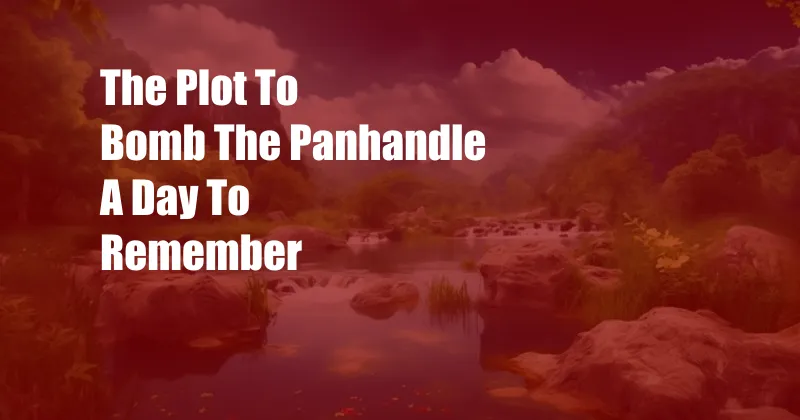
The Plot to Bomb the Panhandle: A Day to Remember
In the annals of terrorism, the plot to bomb the Panhandle stands as a chilling reminder of the depths to which hatred and extremism can plunge humanity. This audacious plan, uncovered in 2019, sought to unleash devastation upon the Florida Panhandle, targeting innocent civilians in a horrifying act of violence. The story of the Panhandle plot is a cautionary tale, shedding light on the insidious nature of domestic terrorism and the importance of vigilance against its threats.
The plot’s genesis lay in the twisted ideology of white supremacist groups, who fueled hatred towards non-whites and sought to incite racial violence. Inspired by the likes of Timothy McVeigh and Dylann Roof, the perpetrators aimed to replicate their heinous crimes and leave an indelible mark of terror upon the American landscape.
The Discovery and Thwarting of the Plot
As the plot unfolded, law enforcement agencies tirelessly worked behind the scenes to gather intelligence and unravel the web of conspiracy. Through meticulous investigations and proactive measures, they intercepted communications and monitored the movements of the suspects. In a decisive operation, federal agents apprehended the group of would-be bombers, preventing them from carrying out their deadly intentions.
The arrest of the plotters and the recovery of explosive materials sent shockwaves through the nation. It became a stark reminder of the insidious threats posed by domestic terrorism and the urgent need to dismantle extremist networks. The swift and effective response by law enforcement agencies underlined the critical role they play in safeguarding the country from such heinous acts.
Unveiling the Motives Behind the Plot
At the heart of the Panhandle plot lay a perverse ideology that dehumanized non-white individuals, viewing them as subhuman and expendable. The perpetrators drew inspiration from neo-Nazi and white supremacist propaganda, which fueled their hatred and justified their plans for violence. They sought to incite a race war, dividing the nation along racial lines and shattering the fabric of American society.
The plot was not an isolated incident but part of a broader trend of white supremacist extremism on the rise in the United States. The perpetrators were active in online forums and hate groups, where they radicalized each other and shared their hateful ideologies. This pervasive online environment became a breeding ground for extremism, providing a platform for the spread of dangerous rhetoric and the recruitment of new members.
Understanding the Impact and Aftermath
The Panhandle plot left an enduring mark on the communities it targeted. The potential for mass casualties and widespread destruction cast a long shadow over the region, creating a sense of fear and insecurity. The aftermath of the plot highlighted the need for increased security measures and community resilience in the face of terrorism.
In the wake of the plot, law enforcement agencies across the country intensified efforts to monitor extremist groups and prevent future attacks. They worked closely with community leaders and organizations to build bridges of trust and foster a spirit of unity against hate. The Panhandle plot served as a wake-up call, prompting a national conversation about the dangers of domestic terrorism and the importance of confronting extremism in all its forms.
Preventing Future Plots: Tips and Expert Advice
To prevent future terrorist plots and safeguard our communities, it is crucial to adopt a proactive approach that addresses both the root causes and the manifestations of extremism. Here are some tips and expert advice:
- Promote Inclusivity and Understanding: Foster a welcoming and inclusive environment where diversity is celebrated and hatred is condemned.
- Educate and Empower: Educate the public about the dangers of extremism and provide tools to recognize and report suspicious activities.
- Support Community Engagement: Engage community leaders and organizations in the fight against extremism, forging partnerships that promote dialogue and bridge divides.
- Monitor Online Spaces: Monitor online forums and social media platforms for extremist content and report suspicious activity to law enforcement.
- Strengthen Law Enforcement Partnerships: Enhance collaboration between law enforcement agencies and communities to share intelligence and develop joint strategies for prevention.
FAQ on the Panhandle Bomb Plot
Q: What were the motives behind the Panhandle bomb plot?
A: The plot was motivated by white supremacist ideology, seeking to incite a race war and inflict mass casualties on non-white individuals.
Q: How was the plot discovered and thwarted?
A: Law enforcement agencies intercepted communications and monitored the movements of the suspects, leading to their arrest and the seizure of explosive materials.
Q: What was the impact of the plot on the community?
A: The plot created a sense of fear and insecurity, highlighting the need for increased security measures and community resilience against terrorism.
Q: What can be done to prevent future plots?
A: Proactive measures include promoting inclusivity, educating the public, supporting community engagement, monitoring online spaces, and strengthening law enforcement partnerships.
Conclusion
The plot to bomb the Panhandle serves as a stark reminder of the ever-present threat of domestic terrorism. It underscores the importance of vigilance, community engagement, and law enforcement collaboration in preventing such heinous acts. By understanding the motives behind extremist violence and adopting proactive measures, we can safeguard our communities and create a more just and peaceful society.
Are you interested in learning more about the Panhandle bomb plot and related issues of domestic terrorism? Join us in the comments section below and let’s continue the conversation.